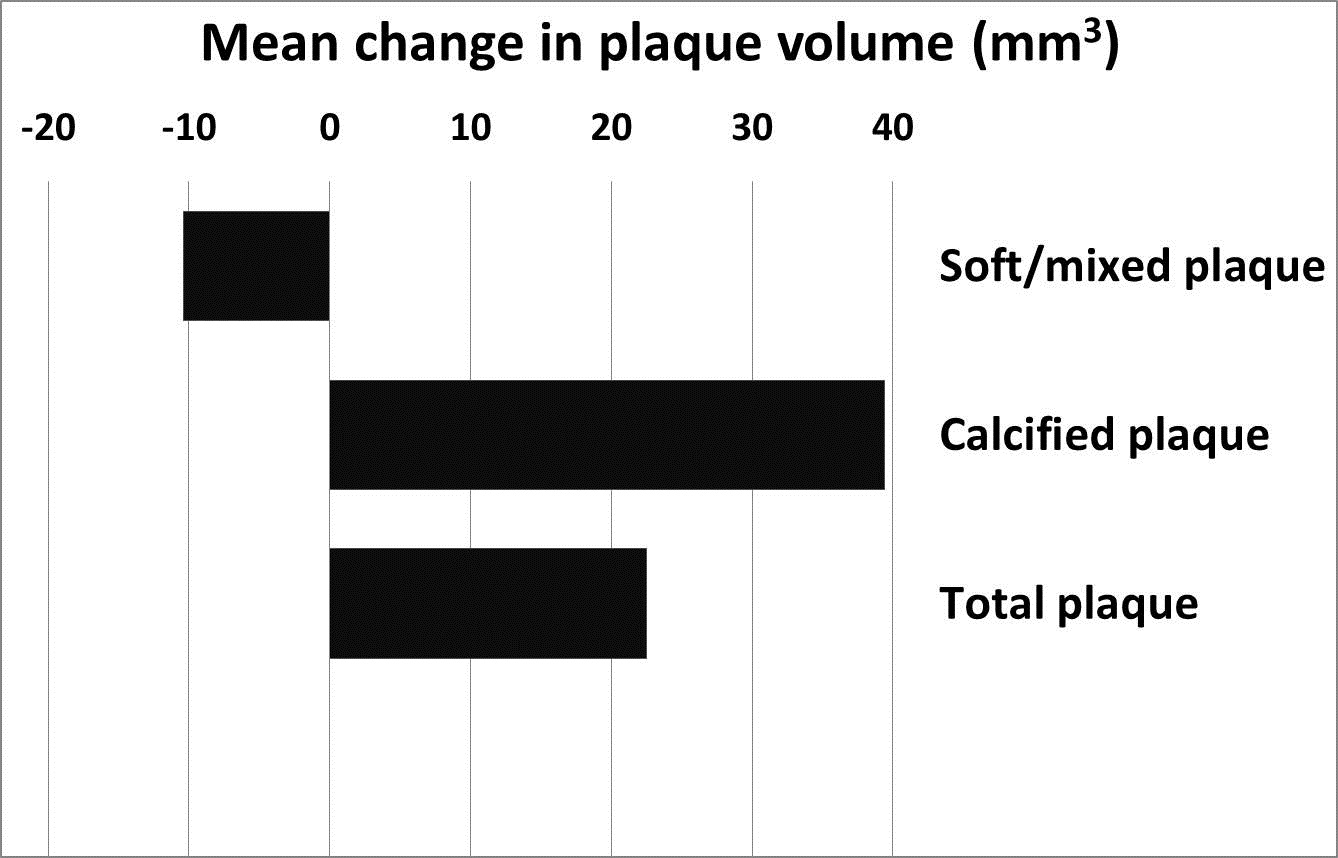Session Information
Date: Sunday, October 21, 2018
Title: Rheumatoid Arthritis – Diagnosis, Manifestations, and Outcomes Poster I: Comorbidities
Session Type: ACR Poster Session A
Session Time: 9:00AM-11:00AM
Background/Purpose: Statins have an established preventive effect on coronary artery disease in the general population. The effect of statins on coronary plaque progression and characteristics in patients with inflammatory joint diseases (IJD) is unknown. Our aim was to evaluate the change in coronary atherosclerosis in long-term statin-treated patients with IJD.
Methods: Sixty-eight patients with IJD and carotid artery plaque(s), underwent coronary computed tomography angiography before and after 4.7 (range 4.0-6.0) years of statin treatment. The treatment target for low density lipoprotein cholesterol (LDL-c) was ≤1.8 mmol/L. Changes in coronary artery calcification (CAC) and coronary artery plaque volume (calcified, mixed/soft and total) from baseline to follow-up were assessed using the 17-segment model of the American Heart Association. Linear regression analysis was used to identify predictors of atherosclerotic progression.
Results: Coronary plaques were present in 42% of the patients at baseline and in 51% at follow up. Mean CAC score increased with 173±284, calcified plaque volume with 39.4±78.3 mm3 and total plaque volume with 22.8±54.6 mm3 (p=<0.01, for all) (Figure 1). Mean mixed/soft plaque volume decreased with -10.4±27.5 mm3 (p=<0.01). At follow-up, 51% of the patients had obtained LDL-c treatment target. Compared to patients above LDL-c target, patients with an LDL-c ≤1.8 mmol/L experienced reduced median progression of both CAC (21 [2-143] vs. 69 [16-423], p<0.01) and total plaque volume (0.08 [-1.0-13.9] vs. 13.0 [0.0-60.8], p=0.02) (Table 1).
Conclusion: We revealed a progression of atherosclerotic plaque volume in statin-treated patients with IJD, mainly due to calcifications. However, soft, unstable plaques were reduced, probably as a result of an alteration in plaque composition from mixed/soft plaques into calcified, stable plaques. Patients with recommended LDL-c levels at follow-up experienced a reduced atherosclerotic progression compared to patients with LDL-c levels above the treatment target. Our results support the importance of treatment to guideline recommended lipid targets in IJD patients.
Figure 1
Table 1
|
LDL ≤1.8mmol/L n=34
|
LDL >1.8mmol/L n=34
|
p-value*
|
|
|
LDL-c level baseline, mean±SD |
3.7±0.9
|
4.4±1.0
|
<0.01
|
|
LDL-c level follow-up, mean±SD |
1.5±0.2 |
2.4±0.7 |
<0.01 |
|
Change LDL-c level, mean±SD |
-2.2±0.9 |
-1.9±1.3 |
0.38 |
|
Change in Calsiumscore, median (IQR) |
21 (2, 143)
|
69 (16, 423)
|
<0.01
|
|
Change in soft/mixed plaque, median (IQR)
|
0 (-3.5, 0.0)
|
0 (-15.7, 0.0)
|
0.71
|
|
Change in calcified plaque, median (IQR) |
1.7 (0.0, 17.3)
|
13.4 (1.5, 107.6)
|
0.02
|
|
Change in total plaque volume, median (IQR)
|
0.08 (-1.0, 13.9)
|
13.0 (0.0, 60.8)
|
0.02
|
*independent samples t-test
To cite this abstract in AMA style:
Rollefstad S, Svanteson M, Kløw NE, Hisdal J, Ikdahl E, Sexton J, Haig Y, Semb AG. Effects of Statin-Treatment on Coronary Plaques in Patients with Inflammatory Joint Diseases [abstract]. Arthritis Rheumatol. 2018; 70 (suppl 9). https://acrabstracts.org/abstract/effects-of-statin-treatment-on-coronary-plaques-in-patients-with-inflammatory-joint-diseases/. Accessed .« Back to 2018 ACR/ARHP Annual Meeting
ACR Meeting Abstracts - https://acrabstracts.org/abstract/effects-of-statin-treatment-on-coronary-plaques-in-patients-with-inflammatory-joint-diseases/

